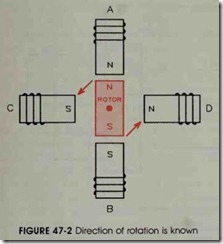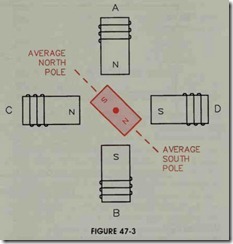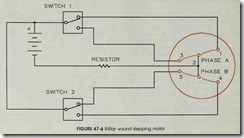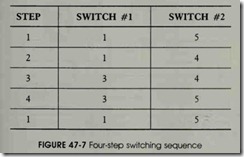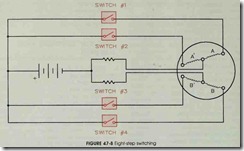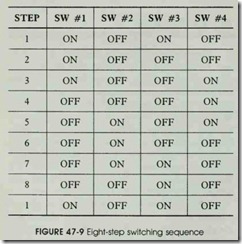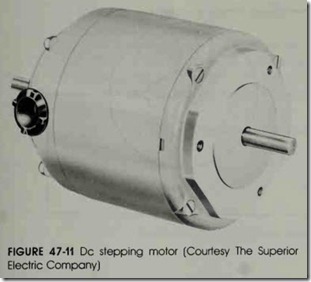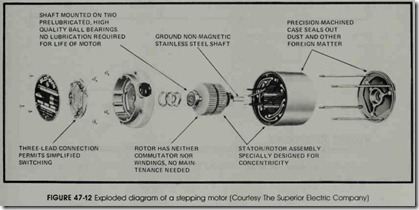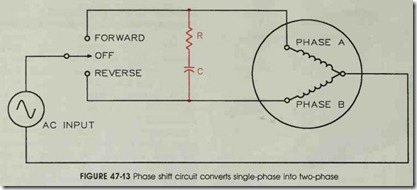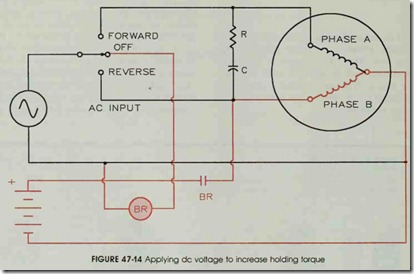Objectives
After studying this unit, the student will be able to:
• Describe the operation of a de stepping motor
• Describe the operation of a stepping motor when connected to ac power
• Discuss the differences between stepping motors and other types of motors
• Discuss the differences between four-step and eight-step switching
Stepping motors are devices that convert elec trical impulses into mechanical movement. Step ping motors differ from other types of de or ac motors in that their output shaft moves through a specific angular rotation each time the motor re ceives a pulse. Each time a pulse is received, the motor shaft moves a precise amount. The stepping motor allows a load to be controlled with regard to speed, distance, or position. These motors are very accurate in their control performance. Gen erally, less than 5% error per angle of rotation ex ists, and this error is not cumulative regardless of the number of rotations. Stepping motors are op erated on de power, but can be used as a two phase synchronous motor when connected to ac power.
THEORY OF OPERATION
Stepping motors operate on the theory that like magnetic poles repel and unlike magnetic poles attract. Consider the circuit shown in figure 47-1. In this illustration, the rotor is a permanent magnet and the stator winding consists of two electromagnetics. If current flows through the winding of stator pole A in such a direction that it creates a north magnetic pole, and through B in such a direction that it creates a south magnetic pole, it would be impossible to determine the di rection of rotation. In this condition, the rotor could turn in either direction.
Now consider the circuit shown in figure 47-2. In this circuit, the motor contains four stator poles instead of two. The direction of current flow through stator pole A is still in such a direction as to produce a north magnetic field; the current flow through pole B produces a south magnetic field. The current flow through stator pole C, however, produces a south magnetic field, and the current flow through pole D produces a north magnetic field. As illustrated, there is no doubt regarding the direction or angle of rotation. In this example, the rotor shaft will turn 90° in a counter-clockwise direction.
Figure 47-3 shows yet another condition. In this example, the current flow through poles A and C is in such a direction as to form a north magnetic pole, and the direction of current flow through poles B and D forms south magnetic poles. In this illustration, the permanent magnetic rotor has rotated to a position between the actual pole pieces.
To allow for better stepping resolution, most stepping motors have eight stator poles, and the pole pieces and rotor have teeth machined into them as shown in figure 47-4. In practice, the number of teeth machined in the stator and rotor determines the angular rotation achieved each time the motor is stepped. The stator-rotor tooth configuration shown in figure 47-4 produces an angular rotation of 1.8° per step.
WINDINGS
There are different methods for winding step per motors. A standard three-lead moto.r is shown in figure 47-5. The common terminal of the two windings is connected to ground of an above- and below-ground power supply. Terminal 1 is connected to the common of a single-pole double throw switch (switch # 1) and terminal 3 is connected to the common of another single-pole double-throw switch (switch #2). One of the stationary contacts of each switch is connected to the positive or above-ground voltage, and the other stationary contact is connected to the nega tive or below-ground voltage. The polarity of each winding is determined by the position setting of its control switch.
Stepping motors can also be wound bifilar as shown in figure 47-6. The term bifilar means that there are two windings wound together. This is similar to a transformer winding with a center tap lead. Bifilar stepping motors have twice as many windings as the three-lead type, which makes it necessary to use smaller wire in the windings. This results in higher wire resistance in the wind ing, producing a better inductive-resistive (L/R) time constant for the bifilar wound motor. The in creased L/R time constant results in better motor performance. The use of a bifilar stepper motor also simplifies the drive circuitry requirements. Notice that the bifilar motor does not require an above- and below-ground power supply. As a gen eral rule, the power supply voltage should be about five times greater than the motor voltage. A current-limiting resistance is used in the common lead of the motor. This current-limiting resistor also helps to improve the L/R time constant.
FOUR-STEP SWITCHING (Full Stepping)
The switching arrangement shown in figure 47-6 can be used for a four-step sequence. Each time one of the switches changes position, the ro tor will advance one-fourth of a tooth. After four steps, the rotor has turned the angular rotation of one “full” tooth. If the rotor and stator have fifty teeth, it will require 200 steps for the motor to rotate one full revolution. This corresponds to an angular rotation of 1.8° per step. (360°/200 steps = 1.8° per step.) Figure 47-7 illustrates the switch positions for each step.
EIGHT-STEP SWITCHING (Half Stepping)
Figure 47-8 illustrates the connections for an eight-stepping sequence. In this arrangement, the center tap leads for phases A and B are connected through their own separate current limiting resis tors back to the negative of the power supply. This circuit contains four separate single pole switches instead of two switches. The advantage of this arrangement is that each step causes the mo tor to rotate one-eighth of a tooth instead of one fourth of a tooth. The motor now requires 400 steps to produce one revolution which produces an angular rotation of 0.9° per step. This results in better stepping resolution and greater speed capa bility. The chart in figure 47-9 illustrates the switch position for each step. Figure 47-10 depicts a solid-state switching circuit for an eight-step switching arrangement. A stepping motor is shown in figure 47-11.
AC OPERATION
Stepping motors can be operated on ac volt age. In this mode of operation, they become two phase ac synchronous constant speed motors and are classified as a permanent magnet induction motor . Refer to the exploded diagram of a stepping motor in figure 47-12. Notice that this motor has no brushes, slip rings, commutator, gears, or belts. Bearings maintain a constant air gap between the permanent magnet rotor and the stator windings. A typical eight-stator pole stepping motor will have a synchronous speed of 72 rpm when con nected to a 60-hertz two-phase ac power line.
A resistive-capacitive network can be used to provide the 90° phase shift needed to change sin gle-phase ac into two-phase ac. A simple forward off-reverse switch can be added to provide direc
tional control. A sample circuit of this type is shown in figure 47-13. The correct values of resis tance and capacitance are necessary for proper op eration. Incorrect values can result in random di rection of rotation when the motor is started, change of direction when the load is varied, erratic and unstable operation, as well as failure of the motor to start. The correct values of resistance and capacitance will be different with different stepping motors. The manufacturer’s recommen dations should be followed for the particular type of stepping motor used.
MOTOR CHARACTERISTICS
When stepping motors are used as two-phase synchronous motors, they have the ability to vir tually start, stop, or reverse direction of rotation instantly. The motor will start within about H cy
cles of the applied voltage and stop within 5 to 25 milliseconds. The motor can maintain a stalled condition without harm to it. Because the rotor is a permanent magnet, no induced current is in the rotor, and no high inrush of current occurs when the motor is started. The starting and running currents are the same. This simplifies the power requirements of the circuit used to supply the mo tor. Due to the permanent magnetic structure of the rotor, the motor does provide holding torque when turned off. If more holding torque is needed, de voltage can be applied to one or both windings when the motor is turned off. An exam ple circuit of this type is shown in figure 47-14. If de voltage is applied to one winding, the holding torque will be approximately 20% greater than the rated torque of the motor. If de voltage is applied to both windings, the holding torque will be about H times greater than the rated torque.
REVIEW QUESTIONS
1. Explain the difference in operation between a stepping motor and a common de motor.
2. What is the principle of operation of a stepping motor?
3. What does the term bifilar mean?
4. Why do stepping motors have teeth machined in the stator poles and rotor?
5. When a stepping motor is connected to ac power, how many phases must be applied to the motor?
6. How many degrees out of phase are the voltages of a two-phase system?
7. What is the synchronous speed of an eight-pole stepping motor when connected to a two-phase 60-hertz ac line? ·
8. How can the holding torque of a stepping motor be increased?

